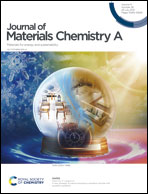Achieving small non-radiative energy loss through synergically non-fullerene electron acceptor selection and side chain engineering in benzo[1,2-b:4,5-b′]difuran polymer-based organic solar cells†
Abstract
Non-radiative recombination loss (ΔEnon-rad) has become the main limiting factor for the power conversion efficiency (PCE) of organic solar cells (OSCs). Herein, two benzo[1,2-b:4,5-b′]difuran (BDF) polymers (P-FT and P-FP) in combination with two electron acceptors (m-ITIC and Y6) in OSCs were employed to systemically investigate the impact of molecular orientation and interaction on energy loss in OSCs. The use of the Y6 acceptor instead of ITIC provided a reduced energy loss in OSC, regardless of the donor used, and the energy loss was lower in OSC based on P-FP, as compared to that based on P-FT. ΔEnon-rad as small as 0.23 eV was obtained in the P-FP:Y6 device, due to the small energetic disorder. In addition, the P-FP:Y6 device also possessed a promising EQEmax of 86.7%. These results provide a deep understanding of the role molecular interactions between the polymer donor and acceptor play in reducing energy loss and promoting device performance through synergic selection and optimization of donor and acceptor in OSCs.
![Graphical abstract: Achieving small non-radiative energy loss through synergically non-fullerene electron acceptor selection and side chain engineering in benzo[1,2-b:4,5-b′]difuran polymer-based organic solar cells](/en/Image/Get?imageInfo.ImageType=GA&imageInfo.ImageIdentifier.ManuscriptID=D1TA04214A&imageInfo.ImageIdentifier.Year=2021)


 Please wait while we load your content...
Please wait while we load your content...